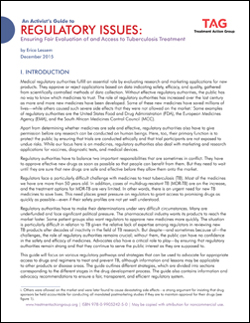Download:

Ensuring Fair Evaluation of and Access to Tuberculosis Treatment
by Erica Lessem
December 2015
From the Introduction
Medical regulatory authorities fulfill an essential role by evaluating research and marketing applications for new products. They approve or reject applications based on data indicating safety, efficacy, and quality, gathered from scientifically controlled methods of data collection. Without effective regulatory authorities, the public has no way to know which medicines to trust. The role of regulatory authorities has increased over the last century as more and more new medicines have been developed. Some of these new medicines have saved millions of lives—while others caused such severe side effects that they were not allowed on the market. Some examples of regulatory authorities are the United States Food and Drug Administration (FDA), the European Medicines Agency (EMA), and the South African Medicines Control Council (MCC).
Apart from determining whether medicines are safe and effective, regulatory authorities also have to give permission before any research can be conducted on human beings. Here, too, their primary function is to protect the public by ensuring that trials are conducted ethically and that trial participants are not exposed to undue risks. While our focus here is on medicines, regulatory authorities also deal with marketing and research applications for vaccines, diagnostic tests, and medical devices.
Regulatory authorities have to balance two important responsibilities that are sometimes in conflict. They have to approve effective new drugs as soon as possible so that people can benefit from them. But they need to wait until they are sure that new drugs are safe and effective before they allow them onto the market.
Regulators face a particularly difficult challenge with medicines to treat tuberculosis (TB). Most of the medicines we have are more than 50 years old. In addition, cases of multidrug-resistant TB (MDR-TB) are on the increase, and the treatment options for MDR-TB are very limited. In other words, there is an urgent need for new TB medicines to save lives. This need places great pressure on regulators to grant access to promising drugs as quickly as possible—even if their safety profiles are not yet well understood.
Regulatory authorities have to make their determinations under very difficult circumstances. Many are underfunded and face significant political pressure. The pharmaceutical industry wants its products to reach the market faster. Some patient groups also want regulators to approve new medicines more quickly. The situation is particularly difficult in relation to TB given the relative lack of expertise among regulators in reviewing new TB products after decades of inactivity in the field of TB research. But despite—and sometimes because of—the challenges, the role of regulatory authorities remains crucial; without them, the public can have no confidence in the safety and efficacy of medicines. Advocates also have a critical role to play—by ensuring that regulatory authorities remain strong and that they continue to serve the public interest as they are supposed to.
This guide will focus on various regulatory pathways and strategies that can be used to advocate for appropriate access to drugs and regimens to treat and prevent TB, although information and lessons may be applicable to other products or disease areas. The guide outlines different strategies, which are divided into sections corresponding to the different stages in the drug development process. The guide also contains information and advocacy recommendations to ensure a fair, transparent, and efficient regulatory system.
